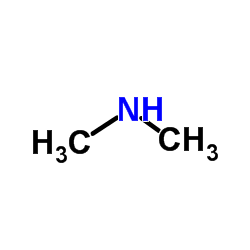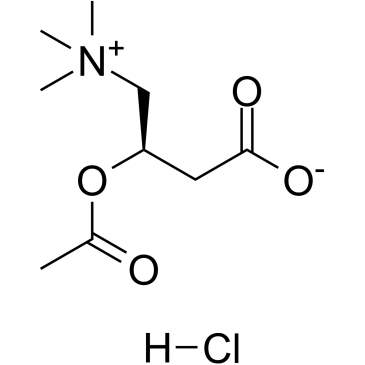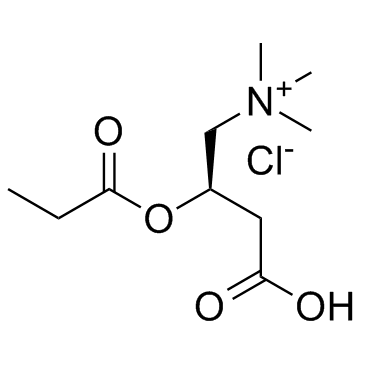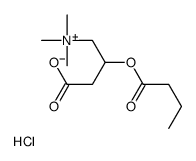6645-46-1
| Name | L-Carnitine hydrochloride |
|---|---|
| Synonyms |
(−)-β-Hydroxy-γ-(trimethylammonio)butyrate
3-Carboxy-2-hydroxy-N,N,N-trimethyl-1-propanaminium chloride 3-Hydroxy-4-(trimethylammonio)butanoate hydrochloride Vitamin BT Hydrochloride Carnitine chloride L-CARNITINE HYDROCHLORIDE 3-Hydroxy-4-(trimethylammonio)butyrate Hydrochloride (R)-3-Carboxy-2-hydroxy-N,N,N-trimethyl-1-propanaminium chloride MFCD00066100 L(-)-Carnitine hydrochloride [(2R)-3-carboxy-2-hydroxypropyl]-trimethylazanium,chloride (2R)-3-Carboxy-2-hydroxy-N,N,N-trimethyl-1-propanaminium, inner salt, hydrochloride (1:1) LEVOCARNITINE HYDROCHLORIDE (R)-3-Hydroxy-4-(trimethylammonio)butanoate hydrochloride 3-Carboxy-2-hydroxy-N,N,N-trimethyl-1-propanaminium, inner salt, hydrochloride (1:1) (2R)-3-Carboxy-2-hydroxy-N,N,N-trimethyl-1-propanaminium chloride QV1YQ1K1&1&1 &&Anhydro HCl DL-Carnitine Hydrochloride EINECS 229-663-6 UNII:F64264D63N (R)-Carnitine hydrochloride L-(-)-Carnitine hydrochloride carnitine hydrochloride QV1YQ1K1&1&1 &&Chloride (3R)-3-Hydroxy-4-(trimethylammonio)butyrate hydrochloride (3R)-3-Hydroxy-4-(trimethylammonio)butanoate hydrochloride (1:1) 1-Propanaminium, 3-carboxy-2-hydroxy-N,N,N-trimethyl-, chloride, (2R)- (1:1) Levocarnitine chloride VITAMIN BT (3R)-3-Hydroxy-4-(trimethylammonio)butanoate hydrochloride L-Carnitine HCl 1-Propanaminium, 3-carboxy-2-hydroxy-N,N,N-trimethyl-, chloride (1:1) 3-Carboxy-2-hydroxy-N,N,N-trimethylpropan-1-aminium chloride (R)-3-Hydroxy-4-(trimethylammonio)butyrate hydrochloride 1-propanaminium, 3-carboxy-2-hydroxy-N,N,N-trimethyl-, inner salt, (2R)-, hydrochloride (1:1) |
| Description | L-Carnitine hydrochloride ((R)-Carnitine hydrochloride), a highly polar, small zwitterion, is an essential co-factor for the mitochondrial β-oxidation pathway. L-Carnitine hydrochloride functions to transport long chain fatty acyl-CoAs into the mitochondria for degradation by β-oxidation. L-Carnitine hydrochloride is an antioxidant. L-Carnitine hydrochloride can ameliorate metabolic imbalances in many inborn errors of metabolism[1][2][3]. |
|---|---|
| Related Catalog | |
| Target |
Human Endogenous Metabolite |
| In Vivo | L-Carnitine hydrochloride ((R)-Carnitine hydrochloride) (125, 250 mg/kg; i.p.) has a more pronounced bronchodilator effect in this chronic murine asthma model, and decreases urinary LTE4 excretion[4]. Animal Model: 8- to 10-weeks-old and weighed 28-30g BALB/c mice[4] Dosage: 125, 250 mg/kg Administration: i.p. Result: SaO2 increased significantly at 250 mg/kg and decreased urinaryLTE4 excretion. |
| References |
| Melting Point | 142 °C |
|---|---|
| Molecular Formula | C7H16ClNO3 |
| Molecular Weight | 197.660 |
| Exact Mass | 197.081863 |
| PSA | 60.36000 |
| Water Solubility | soluble |
CHEMICAL IDENTIFICATION
HEALTH HAZARD DATAACUTE TOXICITY DATA
|
| Personal Protective Equipment | dust mask type N95 (US);Eyeshields;Gloves |
|---|---|
| Hazard Codes | Xi:Irritant |
| Risk Phrases | R36/37/38 |
| Safety Phrases | S26-S37/39 |
| RIDADR | NONH for all modes of transport |
| WGK Germany | 2 |
| RTECS | BP2979100 |
| HS Code | 2923900090 |
| Precursor 9 | |
|---|---|
| DownStream 3 | |
| HS Code | 2923900090 |
|---|---|
| Summary | 2923900090 other quaternary ammonium salts and hydroxides。Supervision conditions:None。VAT:17.0%。Tax rebate rate:9.0%。MFN tariff:6.5%。General tariff:30.0% |


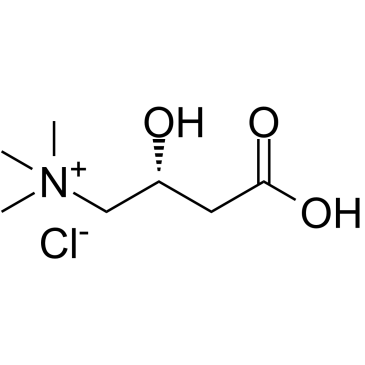


![(+)-(3R,2'S)-ethyl 3-[(2-methoxy-2-phenylacetyl)oxy]-4-(triethylammonio)butanoate iodide structure](https://image.chemsrc.com/caspic/063/107799-28-0.png)



